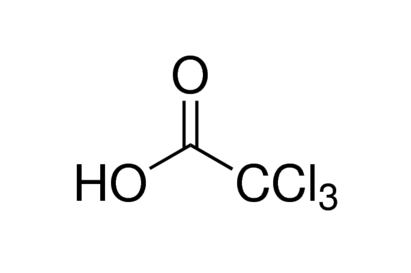產品櫥窗
-
Trichloroacetic acid, >99%
|
產品型號:101-76-03-9 商品規格: |
 |
Protein precipitation reagent Trichloroacetic acid is used as a precipitating agent in biochemistry for precipitation of proteins, DNA and RNA. Synonym: TCA
Cl3CCOOH
M.W.: 163.39
Protein precipitation reagent Trichloroacetic acid is used as a precipitating agent in biochemistry for precipitation of proteins, DNA and RNA. It is an active ingredient used for cosmetic treatments like chemical peels, tattoo removal and the treatment of warts including genital warts. It is also used to determine protein concentration and a decalcifier and fixative in microscopy.
Application:
• Trichloroacetic acid has been used for the precipitation of sLRP (soluble circulating low density lipoprotein receptor-related protein-1) isolated from plasma.
• It has been used for the extraction of ascorbic acid from plant samples. It has also been used for the preparation of ascorbate standards for ascorbate assay.
• It has been used for the precipitation of IMAC (immobilized metal ion affinity chromatography)-isolated phosphoproteins.
Traditionally used to precipitate protein. Has been used to determine protein concentration by quantitative precipitation. Used as decalcifier and fixative in microscopy.
Note:
Moisture sensitive. Hygroscopic. Store in cool place. Incompatible with strong oxidizing agents, strong bases and amines.
Impaired lipoprotein receptor-mediated peripheral binding of plasma amyloid-? is an early biomarker for mild cognitive impairment preceding Alzheimer's disease. Sagare AP et al. Journal of Alzheimer'S Disease 24, 25-25, (2011)
Measurement of reduced, oxidized and total ascorbate content in plants. Gillespie KM and Ainsworth EA Nature Protocols 2, 871-871, (2007)
Casein Kinase 2 (CK2)-mediated Phosphorylation of Hsp90? as a Novel Mechanism of Rifampin-induced MDR1 Expression. Kim SW et al. The Journal of Biological Chemistry 290, 17029-17029, (2015)
M.W.: 163.39
Protein precipitation reagent Trichloroacetic acid is used as a precipitating agent in biochemistry for precipitation of proteins, DNA and RNA. It is an active ingredient used for cosmetic treatments like chemical peels, tattoo removal and the treatment of warts including genital warts. It is also used to determine protein concentration and a decalcifier and fixative in microscopy.
Application:
• Trichloroacetic acid has been used for the precipitation of sLRP (soluble circulating low density lipoprotein receptor-related protein-1) isolated from plasma.
• It has been used for the extraction of ascorbic acid from plant samples. It has also been used for the preparation of ascorbate standards for ascorbate assay.
• It has been used for the precipitation of IMAC (immobilized metal ion affinity chromatography)-isolated phosphoproteins.
Traditionally used to precipitate protein. Has been used to determine protein concentration by quantitative precipitation. Used as decalcifier and fixative in microscopy.
Note:
Moisture sensitive. Hygroscopic. Store in cool place. Incompatible with strong oxidizing agents, strong bases and amines.
Impaired lipoprotein receptor-mediated peripheral binding of plasma amyloid-? is an early biomarker for mild cognitive impairment preceding Alzheimer's disease. Sagare AP et al. Journal of Alzheimer'S Disease 24, 25-25, (2011)
Measurement of reduced, oxidized and total ascorbate content in plants. Gillespie KM and Ainsworth EA Nature Protocols 2, 871-871, (2007)
Casein Kinase 2 (CK2)-mediated Phosphorylation of Hsp90? as a Novel Mechanism of Rifampin-induced MDR1 Expression. Kim SW et al. The Journal of Biological Chemistry 290, 17029-17029, (2015)
Store at Room Temp.
Hygroscopic.
Hygroscopic.


